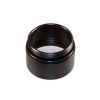YSI 5564A Amplified pH Sensor
The YSI 5564A pH sensor has an internal, battery-powered pre-amplifier for use in difficult environments.
Features
- Measure pH quickly and easily with the YSI 5564A sensor.
- Ideal for high static situations, very cold waters, long cable lengths or long field studies where the connector may be subject to moisture
- Battery life in the sensor can last >2 years if used and stored properly
- Free ground shipping
- Expedited repair and warranty service
- Lifetime technical support
- More
Overview
The YSI 5564A pH and combination pH/ORP sensors have an internal, battery-powered pre-amplifier for use in difficult environments. The amplified sensors are approximately 0.75" (1.91cm) longer than the Model 5564 pH or 5565 pH/ORP Sensors. The available extension adapter attaches to the bulkhead, so the longer sensors fit in the probe guard. All YSI flow cells work normally with the new sensors.
Advantages
- Elimination of potentially erratic readings in high static environments
- Improved sensitivity and stability in applications with very cold waters and for applications requiring long cable lengths
- Applications that require a long duration in the field where there is the potential for exposure of the connectors to moisture
- Potentially longer life if used and stored properly;> 2 years
- (1) YSI 5564A pH electrode
- (1) Storage bottle with solution
- (1) Instruction sheet
- (1) Cleaning certificate
In The News
Ocean acidification: University of Washington's giant plastic bags help control research conditions
With oceans becoming more acidic worldwide, scientists are getting creative in designing experiments to study them. For example, one group at the University of Washington is using giant plastic bags to study ocean acidification. Each bag holds about 3,000 liters of seawater and sits in a cylinder-like cage for stability. The group at UW, made up of professors and students, is controlling carbon dioxide levels in the bags over a nearly three-week period, during which they are looking at the effects of increased acidity on organisms living near the San Juan Islands. “These mesocosms are a way to do a traditional experiment you might do in a lab or classroom,” said Jim Murray, professor of oceanography at the University of Washington.
Read MoreNOAA Alaska buoy network to monitor North Pacific ocean acidification
National Oceanic and Atmospheric Administration scientists detected signs of ocean acidification in the waters that hold the vulnerable and valuable fisheries of the North Pacific off the coast of Alaska, but they only had a snapshot of the action. “We know that in this place were important commercial and subsistence fisheries that could be at risk from ocean acidification,” said Jeremy Mathis, a NOAA Pacific Marine Environmental Laboratory researcher and professor at the University of Alaska Fairbanks. To understand how ocean acidification affects the North Pacific, NOAA scientists created a mooring network that collects constant in situ data on parameters contributing to acidification. They hope it will reveal seasonal trends and patterns left out by their snapshots.
Read MoreSpring 2025 Environmental Monitor Available Now
In the Spring 2025 edition of the Environmental Monitor, we highlight partnerships across the world and the importance of collaboration between government agencies, universities, environmental groups, local communities, and other stakeholders. From great white shark research in Cape Cod to monitoring fisheries in Lake Erie, this latest edition underscores partnerships that connect stakeholders in a watershed through environmental data. With an emphasis on data sharing, a combination of real-time and discrete sampling keeps the public and partners informed of environmental conditions. Our writers also sought out science professionals dedicated to working with peers within and outside of the environmental sector.
Read More









